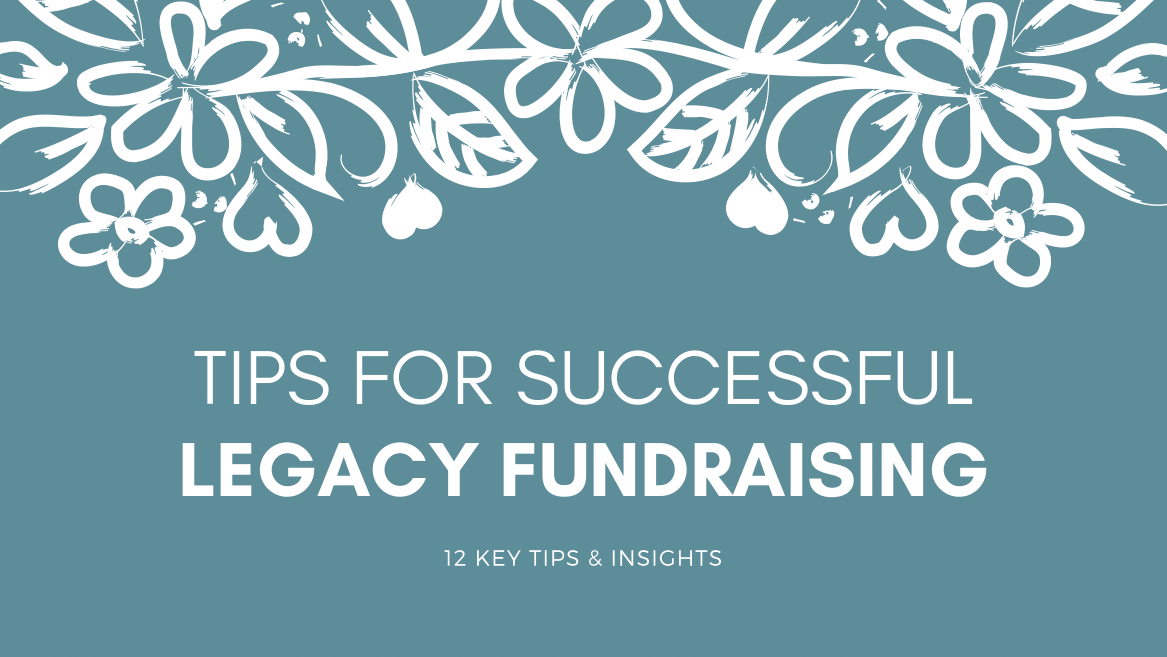Stephen Pidgeon states in his book How To Love Your Donors to Death that the average amount of a bequest in the US is about $37,000. Compare that to the average major gift of $5,000.
With that kind of ROI, is your organization putting enough effort into legacy fundraising?
Donations through bequests can become a major part of a nonprofit’s income.
At the moment, in the US, legacies account for nearly 8% of voluntary contributions, while in the UK, the figure is even higher at around 20%. In spite of their importance, however, charitable bequests have received relatively little attention, compared to other forms of charitable giving.
What is Legacy Fundraising?
Legacy fundraising, also known as planned giving, deferred giving, or bequest fundraising, refers to individuals leaving donations to an organization in their wills. For an individual, such a gift is likely to be the largest donation they will ever give. Simply put, a legacy gift is a gift in a Will to a person or an organization.
Types of legacy gifts/bequests
- Residuary legacy: A gift of the residue (or a share of the residue) of the estate. The residue is whatever is left after all debts, funeral expenses, certain other costs, and tax and any other legacies have been deducted.
- Pecuniary legacy: A gift of a fixed sum of money. The value of a pecuniary gift will decrease over time, as the cost of living increases.
- Specific legacy: A gift of a particular named item – for example, a piece of jewelry, furniture, a painting, buildings, land, house contents, chattels, shares, etc.
- Contingent legacy: A gift that is dependent upon the occurrence of an event that may or may not happen. For example, a gift to a charity which applies only if other beneficiaries named in a will die before the individual dies.
- Life interest / reversionary bequest: A right to enjoy the property, or the proceeds of investment of property, until death or in the case of some reversionary interests, some other event. The beneficiary of a life interest is known as the ‘life tenant’. The interest will cease on the death of the life tenant.
- The gift in remainder/remainder, interest in: An interest/gift in property that comes into effect after a prior interest in the property has ended e.g. in a property subject to a life interest. A beneficiary of a gift/interest in remainder is known as a ‘remainderman’.
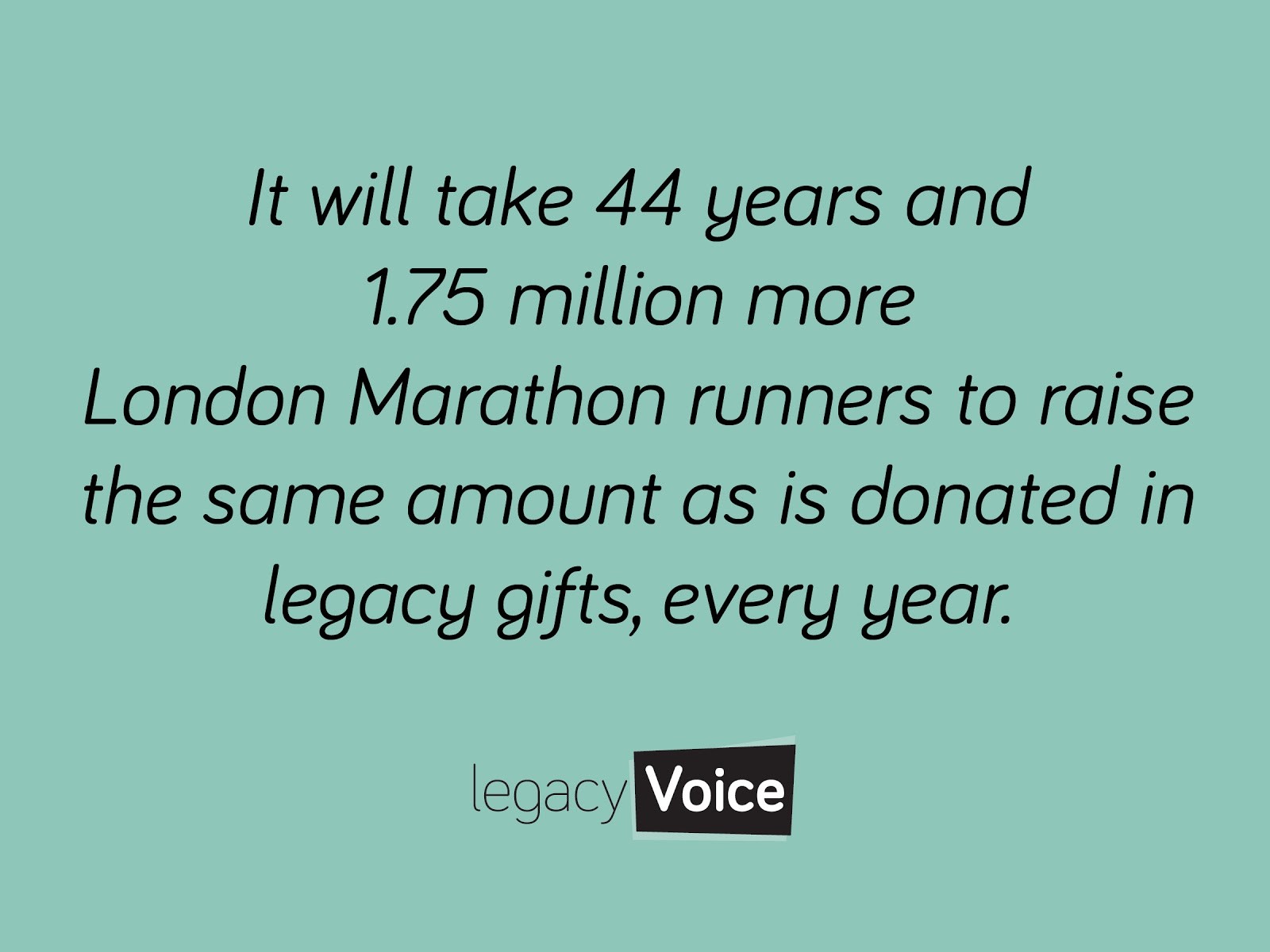
Why are Legacy Gifts Important?
1. There is a largely untapped market.
In the UK for example, 60% of adults do not have wills, according to Co-op Legal Services, leaving a largely untapped market. Remember A Charity says 35% of over-40s in the UK “would be happy to” leave gifts to charity, but only about 6% actually do so.
In the United States, by 2055, approximately $41 trillion will change hands, as Americans transfer accumulated assets to the next generation. It’s also estimated that between $6.6 trillion and $27.4 trillion in charitable giving through bequests will be made to nonprofit organizations by 2052.
2. The financial value is significant.
Bequests are particularly important because of their significant financial value.
Legacies sit at the top of the triangle of all types of fundraising, in terms of the number of dollars raised for each dollar invested.
Here are some stats to share Bloomerang compiled:
- Conventional wisdom per fundraising cost/benefit wizard James Greenfield says that it costs an average of 25 cents to raise a ‘planned giving’ dollar. This definition is commonly considered to incorporate gifts deferred until a later time (e.g., bequests).
- Legacy giving experts at Market Smart claims it costs under one cent.
- A study by Indiana University found donors who included a charity in their wills gave more than twice as much to charity in annual gifts.
- Research by Russell James, J.D., Ph.D., CFP found donor annual gifts increased an average of 75% after they made a legacy gift, skyrocketing long-term giving from these supporters.
3. It’s easy to get started.
A commonly perceived hurdle is the myth of difficulties associated with starting and running a planned giving program. However, creating and running a legacy fundraising program is simpler than it looks.
Some of the other most common excuses for not implementing a planned giving program include donor misperceptions (overly complicated or expensive), not worth the investment of time, thinking it’s only for very large nonprofits, or being unable to comfortably begin a conversation about a donor’s mortality.
Although not every nonprofit has resources to hire one person who does nothing but legacy fundraising, which would be ideal, but it’s easy to get started:
Incorporate bequest legacy goals, objectives, and strategies into your overall written development strategic plan, and make legacy fundraising part of someone’s job description.
12 Key Insights and Tips for Successful Legacy Fundraising
With the 12 tips and insights outlined below, you’ll be ready to get started (or take your legacy fundraising to the next level):
1. Establish a Clear Policy
Before beginning any legacy fundraising activity (especially face-to-face), approve an agreed set of written procedures, clearly establishing a policy on proper practice for this activity.
Communicate this set of procedures to everyone on the team who’s engaged in legacy fundraising activities.
For example, such policy might state that face-to-face meetings in a potential legator’s home to discuss legacies should only occur if that person has first had the opportunity to decline the meeting.
2. Know Your Context and Your Audience
Stay aware of key trends impacting legacy fundraising. For example, we know that the overarching economic backdrop, property prices, death rates, and changing patterns of consumption, which include changing pension investments and growing care costs linked with an aging society, can have a hefty influence on what nonprofits might receive in legacy gifts each year.
For best results in legacy fundraising, it’s also key to understand your audience.
Have some system of CRM in place to help you manage and maximize all your fundraising relationships – including legacy prospects.
Donor profile criteria.
Starting with your own data, determine the typical profile of donors who have left your nonprofit a legacy gift over the last 12 months.
- Are they primarily male or female, or is it an even split?
- How old are individuals when they leave a gift to your charity?
- Where do they live?
- How long is it between them writing their Will and you receiving the legacy?
- What are your average values across the different types of legacies?
- What is the average over two/five/10 years?
For example, in the UK the typical profile of a legator is:
- Female
- 77 years of age when she writers her last Will (but 81 is the most common age)
- On average dies at 84 (although the most common age is 89)
- The lapse between the date of Will and date of death is 7 years and 2 months
- Lives in the South of England
- Leaves 3.4 bequests to charity (Source.)
Here’s how it is in the United States, according to the Giving USA Foundation:
- The average age donors wrote their first will was 44 years old and almost all (91.6%) used a legal advisor to write their wills.
- Over half (53%) of donors established their first planned gift at the time of writing their first will.
- The average age at which donors made their first planned gift was 52.8 years old. Among gay and lesbian donors, the average age of the first gift was slightly younger, at 50 years old. (Source.)
Pay attention to legacy marketing.
To know your audience, record your supporter’s details correctly and update your data regularly. Out-of-date or inaccurate data generates waste, expense, and sometimes even upset (for example, if you misspell a supporter’s name or get their address wrong.)
Keep track of the legacy marketing status of your supporters. Are they an ‘enquirer’ (having requested information on how to leave a legacy), an ‘intender’ (having stated an intention to include your charity in their Will), or a ‘pledger’ (having already included your charity in their Will)?
This information will help you with legacy forecasting, legator profiling, and personalizing your approach to the different audience segments.
Pro tip: The need to provide and protect one’s family (especially dependent children) is a very real and present barrier to leaving a legacy gift. Therefore, the bulk of your strategy shouldn’t be aimed at getting people in their thirties and forties (with families) to leave a legacy to your cause. You’re likely to be more successful when the second Will is written – probably coinciding with retirement – when the pressure to provide for children lessens as they become independent and successful in their own right.
Many nonprofits, like Street League (see below), use a ‘family first’ approach to overcome this barrier, by making it clear that you can still leave a gift to your favorite causes once loved ones have been provided for.
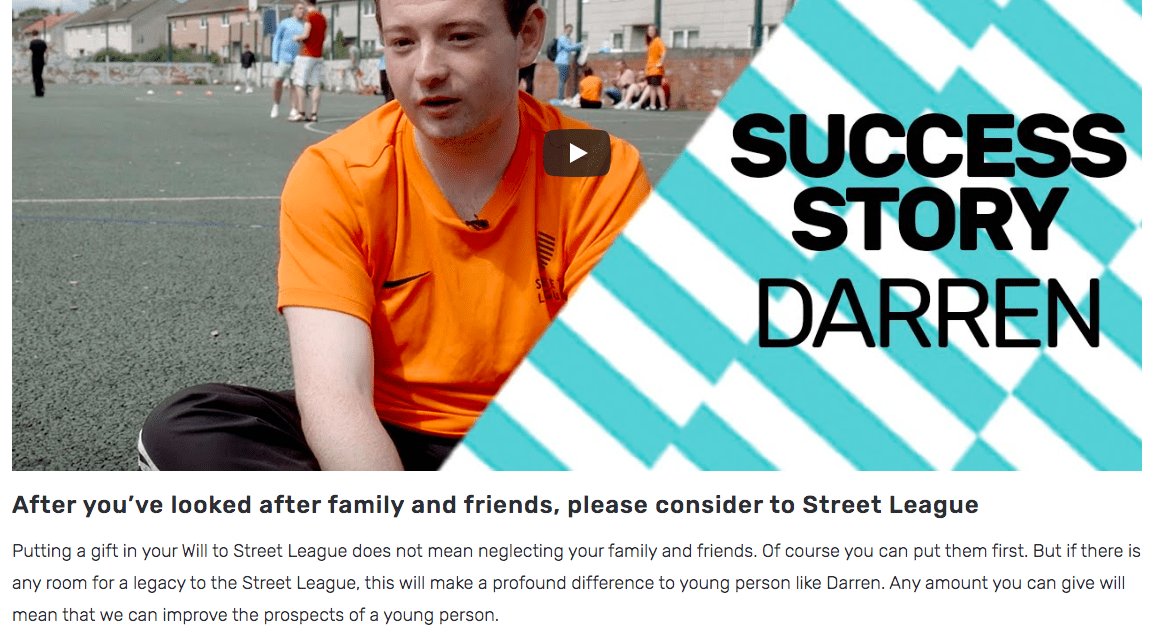
3. Be Sensitive
Legacy fundraising can be a challenging area of work. By its very nature, it consists of sensitive topics and conversations with an individual and potentially their family or next of kin.
Legacy gifts may be received at a time when family members and friends are grieving and those dealing with the gift, often the next of kin or a close friend, may feel particularly sensitive to how it is handled by your nonprofit.
Ensure that donors are thanked appropriately and that any recognition is suitable. Communicate with family and friends of the deceased, including lay executors, with professionalism, courtesy, and sensitivity. Be courteous and professional at all times.
Where names are mentioned or case studies sought and subsequently used, permission should be obtained from the next of kin where possible. Stay mindful of the need to balance the opportunity to promote the support with the sensitivities associated with bereavement.
4. Hone Your Approach
Simply put, most people don’t like to talk about death. This is why it’s key to shift the conversations about legacy fundraising from ‘death’ to ‘life’.
Legacy fundraising shouldn’t be depressing, making us feel as though our mortal end is pending, and it shouldn’t solely focus on the financial or material aspect of giving.
When honing your approach to legacy fundraising, take the emphasis away from dying, and focus on living. Nurture people’s desire to leave not just a financial, but also a social legacy.
Highlight how legacy giving enables people to leave a lasting impression on the world. It’s important to make it clear that gifts don’t have to be large to be meaningful; anyone can make their mark simply by writing their wishes into a Will.
Make legacy fundraising about:
‘What will you be remembered for?’
‘What’s been important to you in your life?’
Also, think about the language you use. Think about the words your supporters use and make these prominent. For example, dry procedural stuff or professional language (e.g., “leave a legacy” is often preferable to “estate planning;” “a gift in your will” is preferable to “a residual bequest.”)
Pro tip: The top three motivations donors cited in Giving USA Foundation, Leaving a Legacy: A New Look at Planned Giving Donors (report) for making a planned gift were: the importance of the cause; the belief that the nonprofit makes a significant impact; and the donor’s ability to make a larger gift through an estate gift than during the donor’s lifetime.

5. Actually Make the Ask
Research shows that if the will-writer just asks someone if they would like to donate, they are more likely to consider it, and the rate of donation roughly doubles.
Behavioral science identified a range of factors that influence how we give. Take time to research what influences giving and then use those insights to take your legacy fundraising to the next level.
For example, we know that giving is ultimately a social act. Researchers found that when JustGiving donors see that the donor before them has made a large donation, they make a larger donation themselves.
Donors to an international development charity were more likely to respond to a match–funding campaign if they knew that the match came from the Bill and Melinda Gates foundation than if it came from an anonymous source.
Gathering donor insights.
Ultimately, making the ask for a legacy gift is a matter of starting a conversation. Get the donor to talk about what’s important or meaningful to them, why they support your organization, and what their legacy might be:
- What’s made our organization special to you and your family?
- What inspires you to do what you do?
- What motivated you to give your first gift to us?
- What do you feel will be the greatest challenges to our organization in the foreseeable future?
- What would you like to see continue as your legacy?
When it comes to the legacy ask, a soft approach is usually best. If speaking directly to a supporter, allow the conversation to be led by them. Listen to their thoughts and feelings about legacy giving, discuss their concerns, and try to resolve them.
Furthermore, digital, and particularly social media, allows for a big impact and reach for relatively little spend to make the ask. Some of the best campaigns have been ones that have broken away from the norm, so don’t be afraid to try new things.
For example, CRUK used the Royal Philharmonic Orchestra playing Vivaldi’s Spring Concerto with a missing third of the score, to show to great effect the role legacies play in funding its work.
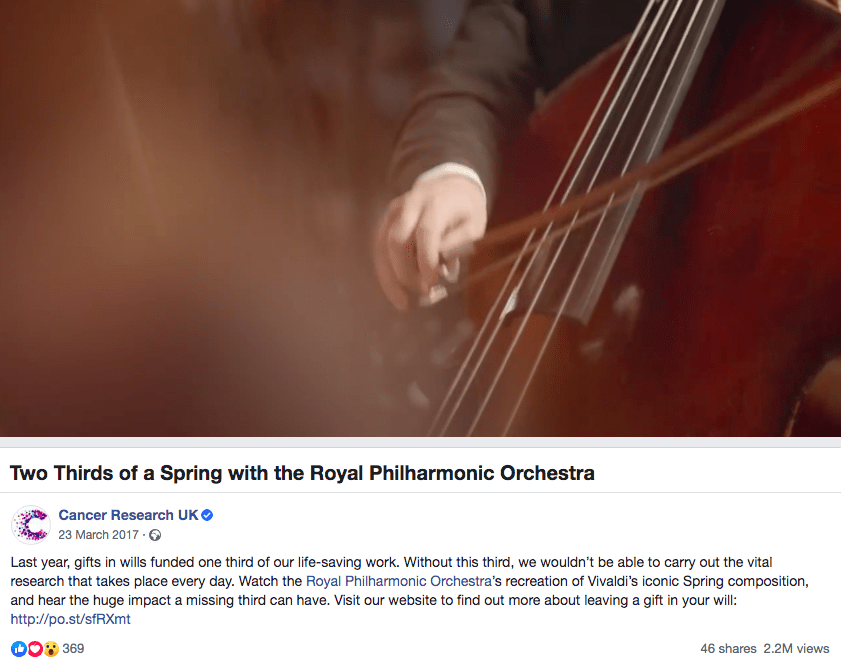
Keep on testing different ideas, creative approaches, channels, messaging, and targeting to see what gets the best responses and from whom.
UNICEF created a Buzzfeed article addressing common myths pertaining to legacy giving.
The opportunities to be creative are plenty!
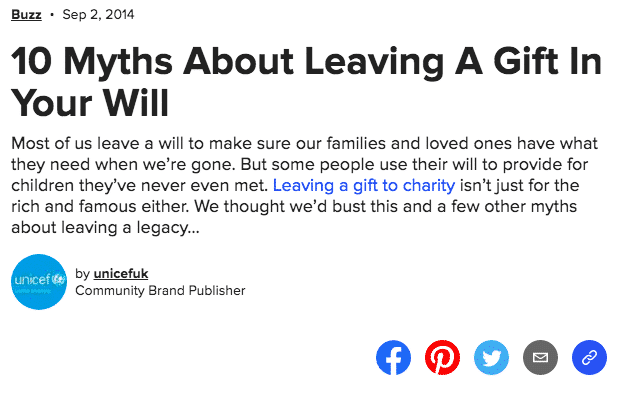
6. Nurture Relationships
According to the Giving USA Foundation, Leaving a Legacy: A New Look at Planned Giving Donors, many of the study’s donors had long histories with the organizations they are supporting in their estate plans. More than 50% of them had been donors for longer than 20 years.
Fundraising for legacy gifts is often built on establishing a long-term relationship between the potential legator (the person who leaves a gift in their Will) and the nonprofit or nonprofits that they choose to donate to.
Legacy marketing takes time to yield results. Usually, someone needs to see legacy messaging multiple times before taking action, so investing in it is a long-term commitment. Legacy marketing campaigns might not prompt someone to write a Will, but when someone does make that step, your nonprofit will be front of mind.
Remember that a legacy in many ways symbolizes someone’s life, their values, and their dreams. When you talk about it, try to spend some time getting to know the person and what they’re passionate about in life. That way you can try and help them see what difference they can make in the future.
Understand donor behavior.
Studies have shown that people move through a series of stages when deciding to change their behavior. From pre-awareness of an idea to contemplation, preparation, action, and finally maintenance. Essentially, you can’t go diving in at the deep end asking people to leave you a legacy when you’ve not taken them on a journey first. You should have an ongoing relationship with your supporters which should be tailored according to the actions or triggers which reveal their stage of consideration. This means being donor-centered and giving them what they want and need, rather than what you want (and it’s also referred to as ‘dripping your legacy fundraising message’).

Read more on dripping your legacy fundraising message here.
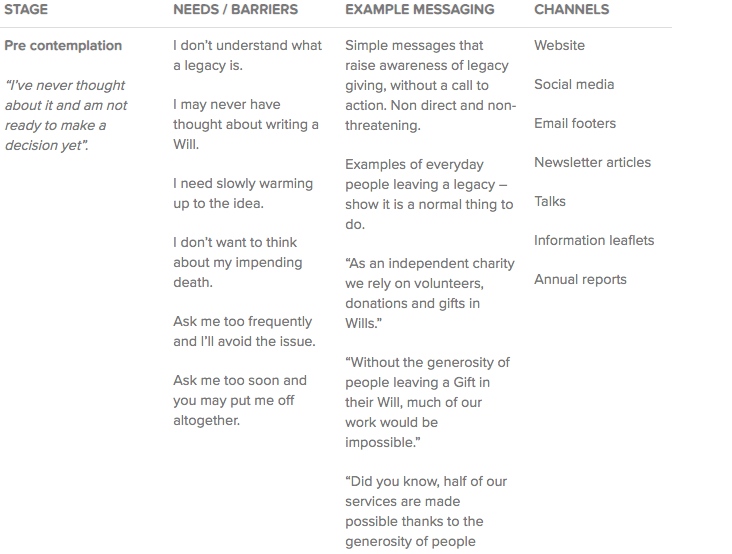
Pro tip: Treat your supporters warmly and kindly. The better your relationship, the more likely they are to consider leaving you a gift in their Will.
7. Promote Your Legacy Giving Program
You can use a wide range of routes to market your legacy program to current and potential legators. These include radio, press, direct mail, inserts, TV, online, and email.
Take great care to ensure the good taste and appropriateness of your promotion – ensuring your promotion takes into account the nature of the cause concerned, the content of the fundraising message, and the likely circumstances and disposition of the audience.
For example, the accident and emergency department of a hospital shouldn’t be considered an appropriate site for promoting legacies.
To promote your legacy program, you can also organize an event, dinner, reception, or tour, for example. If you choose to do that, be transparent about the reason for the invitation to an event, being explicit that legacies will be discussed if the issue is going to be raised.
Elements of a good legacy proposition.
- It should be personal.
- You need to feel passionate about it.
- The mission needs to feel aspirational, believable, and achievable.
- It needs to be tangible – understandable.
- It should be interesting and get people’s attention.
- It should focus on something specific.
- And most of all, it needs to move you – to feel emotional.
(Source.)
Talk about what legacies enable you to do, and who they make a difference to. Share photos of people you have supported on social media, showing what even a small gift can achieve.
Social media is great for driving conversation through shared content and storytelling, encouraging people to ask questions and share views and comments. This is key in helping to normalize legacies.
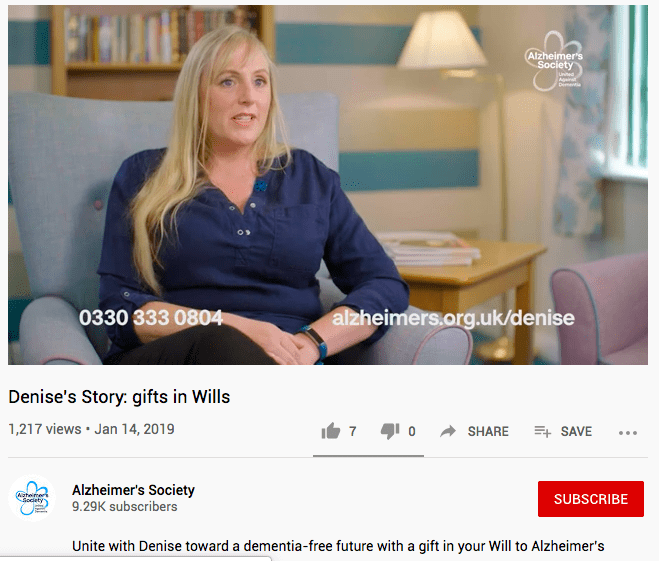
Videos are particularly powerful when it comes to promoting legacy fundraising.
Here are some of our favorites:
Pro tip: Legacy giving is often not communicated nearly as much as other forms of donations. Include legacy giving into your existing marketing campaign to encourage more people to give in this way and move away from the ‘awkwardness’ and taboo of the topic. You can promote legacy giving in your everyday conversations, in your newsletters, and in social media posts.

8. Tell Stories
Stories help your supporters see the difference their legacy gift will make, so be sure to include stories in all your marketing materials.
A great story will tap into your supporter’s emotions and make them care. Remember, people give to people; you will likely make a much stronger emotional connection if you keep your story focused on one individual beneficiary.
People are much more responsive to charitable pleas that feature a single, identifiable beneficiary than they are to statistical information about the scale of the problem being faced. When it comes to charitable giving, we are often ruled by our hearts and not our heads.
Make sure your stories remind them how important gifts in Wills are to your nonprofit – the lives they have saved, the ground-breaking research they have funded, the projects they have stopped from closing – and how much you need them for your future.
Pro tip: Share legators’ stories, communicating why they wanted to leave a gift and what a difference it has made, inspiring others to follow suit. Showcase your future plans so supporters can see your long-term need for funds and how their gift could have a real and lasting impact. Make sure your legators consent before you share any details.
Here’s how RNIB did it.
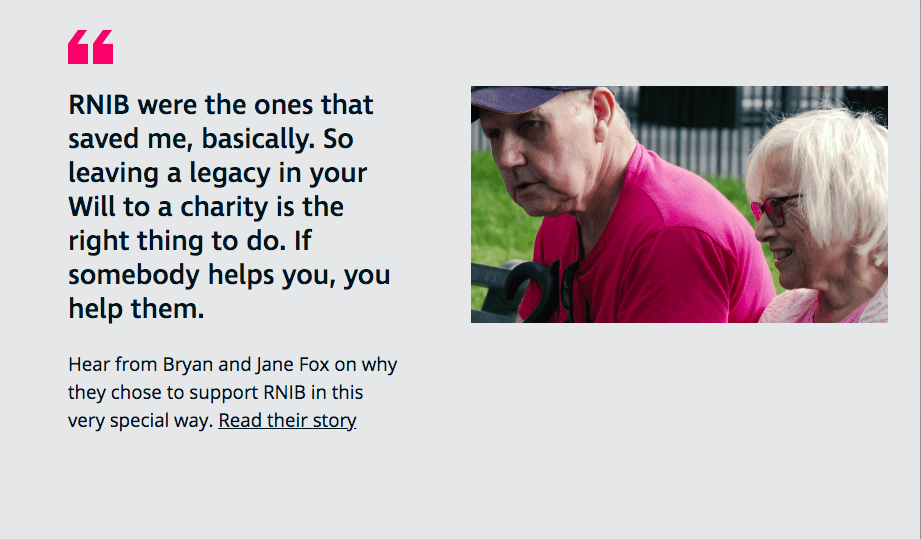
9. Create an Online Legacy Fundraising Site
With the over 60s increasingly embracing the internet, plus a need to engage new and younger audiences, digital channels are fast becoming one of the most effective ways for nonprofits to get the conversation about legacy fundraising started.
It can be hard to pitch the tone of voice and terminology to a wide audience where saying the right thing around a sensitive subject is important. What works in person may not work online.
To create an online legacy fundraising site, start with a well-written, persuasive, and warm copy. Many nonprofits find this hard and lose out on the warmth and engagement in their effort to be sensitive.
WaterAid does a fantastic job at creating an effective online legacy fundraising site.
What they do really well.
- Their images are compelling, positive, and inspiring. Their design is great, with lots of visuals and white space. The copy is great too, evoking emotion without being too cliché; simple enough for most to understand and want to learn more.
- Their copy is powerful: “Include the wonderful gift of water in your will”, and their call to action is clear: “Order your guide to include a gift to WaterAid in your will”. They repeat the call to action throughout the page.
- They use video to strengthen their message.
- They emphasize why legacy gifts are important and what they help achieve.
“A gift in your will could transform lives for generations. It will bring clean water, decent toilets and good hygiene to people all over the world. The impact of clean water on people’s lives is undeniably wonderful and it should be normal for everyone, everywhere. A gift in your will can help make this a reality.”
- They are transparent about how they spend money and they link to their annual report.
- They include a FAQ section, as well as links to useful resources and a way to contact them.
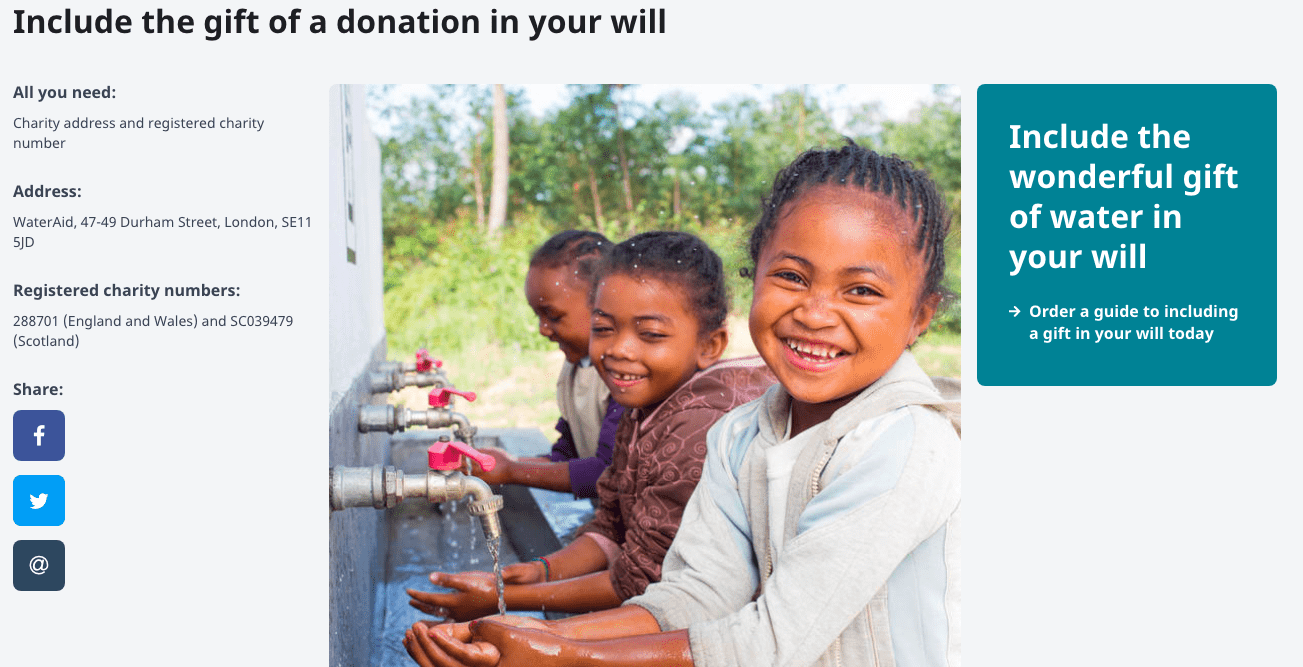
Here’s useful content that you can include in the legacy section of your page:
- Sample legal wording for a will including charity name, address, and charity number
- Information about how to add to an existing will / how to make a codicil
- Information for executors
- Previous names of the charity
- How to leave gifts of items
- Pledge forms so supporters can let you know they have included you in their will
- FAQs/jargon buster about types of gift
- Downloadable guides
- How to calculate the value of your estate
It’s useful to have contact details where supporters can ask questions.
If you have request forms or contact pages, craft your automatic pages to say ‘thank you’ and to explain what happens next.
Read more about online legacy fundraising sites here.
10. Make it Easy for People to Give
Like with all other forms of fundraising, making it easy for donors to give is key to successful fundraising. If it’s too complicated or too long, many will give up.
With legacy gifts, in particular, the legal and tax aspects can be daunting.
So, you need to make it as easy as possible for people to make a Will and leave you a legacy. To do this, you need a high-quality website that can be easily navigated and downloadable legacy resources (such as guides or brochures).
Take time to word your materials and web content in such a way that makes this topic more approachable.
Include any information members will need in the legacies pack.
For example, publish the legal text which legacy givers can include in their Wills. Age UK has included plenty of information and resources to make it easy for people to give a legacy gift.
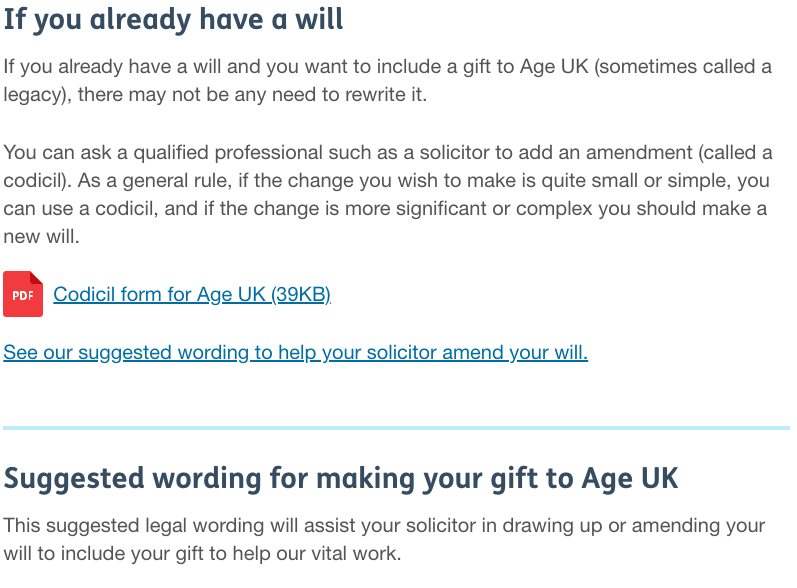
11. Foster a Legacy Fundraising Culture
For your nonprofit to be truly successful at planned giving, you need to foster a culture of legacy fundraising in your organization. To do that:
- Talk about legacy fundraising internally. Overcome any taboos that might exist within your organization (and there might be a few since the topic is about death and money).
- Ensure there’s buy-in at the top. Ensure your trustees, CEO and senior management team are on board with legacies and understand the impact they have or can have on your organization. Can you convince the board to view legacies as a strategic or organizational priority?
- Dedicate resources. Whether you have dedicated legacy fundraisers or not, make sure your fundraisers have the training, resources, and support they need to make a real success of legacies.
12. Take Care of the Legal
Legacy fundraising is a complex area because of the regulatory and legal considerations of leaving Wills and the administration of estates. This means nonprofits and fundraisers have to ensure they are acting appropriately.
For example, it’s crucial that your fundraisers do not provide legal advice. Legacy fundraising materials ought to make it clear, where relevant, that the contents are not intended to constitute legal advice and that potential legators are strongly advised to seek independent professional advice.
It’s advisable to avoid drafting or being directly involved in the drafting of Wills. A fundraiser must not exert undue influence on a potential legator.
In legacy fundraising, keeping records and data on the relationship with a supporter has always been important – especially if there is ever a dispute about the legacy gift in the future. But with GDPR requiring that data isn’t kept forever, getting the balance right on data retention can be tricky.
The Institute of Fundraising has produced a guide to help charities and fundraisers navigate the issues surrounding data retention and legacies.
Pro tip: Stay aware of the potential ethical issues. For example, close relationships can develop between a fundraiser and a potential legator. This can sometimes favor the fundraiser rather than the nonprofit, and a legacy may be left to the individual in their personal capacity, rather than to the nonprofit. Have in place policies and procedures to deal with similar instances.
Over to You
As with all areas of fundraising, legacy fundraising needs investment; time, energy, and resources. Make sure your fundraisers have access to support and training to break down taboos and help them get legacy conversations started.
To really capitalize on legacy fundraising, your nonprofit needs to make legacies a part of your everyday dialogue internally and externally, familiarize stakeholders and supporters alike with the concept of leaving a gift in their Wills and develop effective legacy fundraising strategies.
Great fundraising professionals today understand that a legacy giving program provides critical, and often long-term financial support to an organization.
Choose Donorbox as your donation system and check out our Nonprofit blog for more nonprofit resources and tips.

